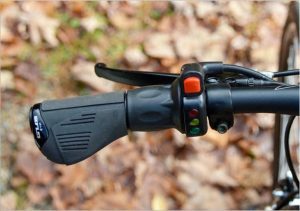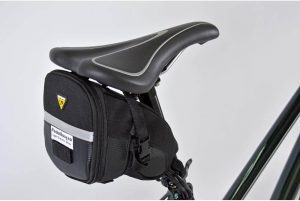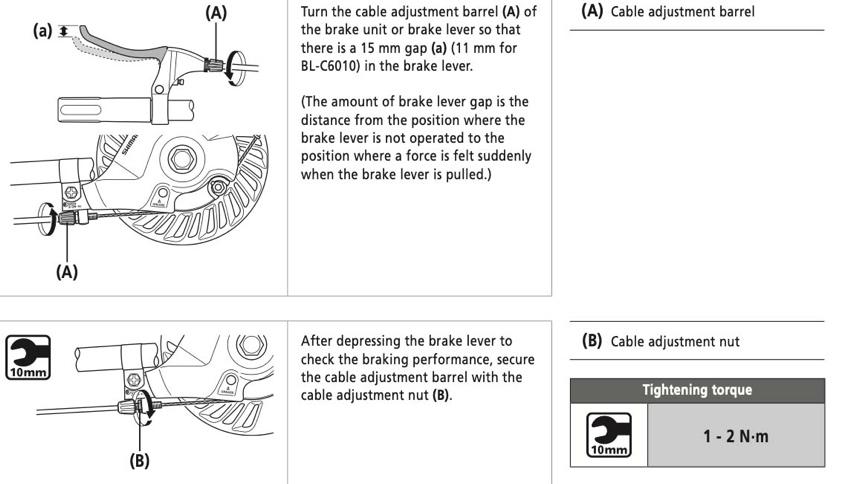Owner’s Manual CF Commuter
CanCycle, Easy Rider and 26” Easy Rider Owner’s Manual (7 speed editions)
Thank you for purchasing a Pedal Easy E-Bike. Your bike has been carefully designed and assembled to provide the ultimate cycling experience by combining the very best elements of a quality bicycle with the added benefit of power assist when you need or want to use it. Best of all, it’s easy to use and maintain.
Please take a moment now to record your bike’s unique serial number. The serial number is stamped into the frame on the bottom of the bottom bracket (lowest part of the frame). If you have someone raise the bike on the rear wheel, you’ll be able to see it. Or you can turn the bike upside down resting on the handlebars and seat to write it down. Hope this helps. Enjoy your cycling!
Serial number_________________________
Specifications
- Weight: 42 lbs
- Frame & fork material double butted, 6061 aluminum, heat treated to T6
- Gearing Shimano Nexus 7 speed SG-C3000-7R
- Shifter Shimano Nexus Revo-shifter
- Brakes: Front…Tektro V-brake, Rear…Shimano roller BR C3010-R
- Front/rear chain ring 46/20
- Tires CST Traveler City Classic, 700 x 38c touring/commuting
- Motor 36V, 350W power at the wheel, planetary-geared front hub Bafang G311
- Controller Sinusoidal
- Battery Lithium-ion Samsung INR, 320 W.h capacity
Preliminary Safety Checklist: If your bike has been shipped to you (as opposed to picked up at our shop) then prior to use, please do the following, or have your bike mechanic confirm all the following precautions in case something was disturbed during shipping:
- Brakes
- Check that both front & rear brakes effectively stop the bicycle and pads do not rub when wheels turn.
- Wheels & tires
- Check tire pressure is correct (see specs below)
- Ensure front and rear axle nuts are tightened to specifications (see below).
- Saddle
- Adjust to proper height for rider & ensure clamp is secure
- Ensure minimum insertion mark on the seat post is not visible.
- Steering
Check alignment of forks, handlebar with direction of travel
- Chain
- Check that the chain runs free and is properly tensioned. (see “Maintenance” below)
- Cranks & Pedals
- Check cranks are secure to spindle (axle)
- Check pedals are securely fastened.
- Internal hub & shifter
- Check for proper shifting
- Frame & Fork
- Check that the frame & fork are undamaged.
- Electrical
Check for proper functioning of handlebar on/off switch and throttle.
- Safety
- Check that reflectors are visible, bell is functional, and rider helmet is worn.
- In Ontario, riders of power-assisted bikes must be over 16 years old and wear a helmet.
Warranty
There is a two-year replacement warranty on all bicycle parts, including electrical, should any parts fail due to manufacturing defects.
Disclaimer: Pedal Easy is not liable for any injury that may occur while using the Pedal Easy Bicycle. Please consult the manual before using our product and always wear a helmet.

Easy Rider pictured. All components on the CanCycle and 26” Easy Rider are similar.
Shifting Gears
Internal-gear hubs, unlike derailleurs, can be shifted multiple gears at a time while stationary, coasting, or lightly pedaling. Twist the shift collar forwards to gear down, and backwards to gear up.

Power control
A half-grip twist throttle on the left side of the handlebar controls power to the motor. Rotating the throttle provides fine control proportional to the amount of power assist. For safety, the throttle spring returns to zero assist (no power) when released. The half-grip allows the rider to comfortably maintain throttle position while riding (index finger and thumb grip the throttle, while the other fingers hold the stationary part of the handlebar half-grip). We also have thumb throttle and finger throttle options. For comfort and upper-body cushioning, the palms should rest on the rubber lip at the rear of the ergonomic grips.
 To activate the motor, push the red Power button. There are 3 LED lights (red, yellow, green) that give an indication of how much charge (energy) is in the battery. When all 3 LEDs are on, the battery is fully charged. At around 50% charge the bottom light (green) goes out; and when charge reduces to about 15% the middle light (yellow) goes out. The top light (red) stays on all the time the switch is “on”. The power switch should be turned “off’ whenever the bicycle is to be left unattended. Leaving it on not only drains the battery but also it is a safety hazard as someone may inadvertently twist the throttle, in which case the bicycle will move forward.
To activate the motor, push the red Power button. There are 3 LED lights (red, yellow, green) that give an indication of how much charge (energy) is in the battery. When all 3 LEDs are on, the battery is fully charged. At around 50% charge the bottom light (green) goes out; and when charge reduces to about 15% the middle light (yellow) goes out. The top light (red) stays on all the time the switch is “on”. The power switch should be turned “off’ whenever the bicycle is to be left unattended. Leaving it on not only drains the battery but also it is a safety hazard as someone may inadvertently twist the throttle, in which case the bicycle will move forward.
Power Assisted Cycling
The motor drives the front wheel of the bicycle, and the pedals drive the rear wheel. The front wheel drive helps with stability when cycling on sand or other soft ground, effectively “pulling” the front wheel in the direction of travel and preventing it from “ploughing”. The two drive systems (battery-power at the front and rider-power at the rear) are independent, so either can be used alone or both can be used simultaneously…that is, you can power the bike by pedaling only, just like a conventional bike, or you can power the bike by motor only (using the throttle) without pedaling, or you can pedal & use the throttle for assistance at the same time. When approaching a hill, particularly a steep one, engage the power before you get to the hill, and keep the speed up. If you slow too much when you’re on the hill, motor efficiency drops, which can cause it to feel below normal power.
CAUTION: On ice be careful with use of the throttle, particularly when cornering, as it can spin the wheel and possibly initiate a front wheel skid.
Battery
The battery is the heart of the e-bike. We use only Panasonic or Samsung Lithium-Ion cells, the gold standard. Feel free to charge after every use. There is no “memory effect” as there is with some other battery types, so charging at partial depletion has no negative effect on the battery. Charging when the battery temperature is below 0 °C can damage it. Using the battery at low temperatures, however, is not a problem. When used at low temperature though, the range is reduced (at minus 20°C the distance you can go on a charge is about half what it normally is). Avoid storing the battery at elevated (>25°C) temperature. Sub-zero storage temperatures are fine. Do not drop the battery on a hard surface. Retake photo with current battery in trunk bag

Battery Charging
The small black plug on the battery plugs into the charger. The charger is plugged into a standard 110V AC household electrical outlet (or car inverter). The charger will also work on 220V AC power with a suitable outlet adapter. The charger has single power-on light that changes from red to green when the battery is fully charged. The battery can be left on the bike while charging, in a garage for example, or it can be removed for charging elsewhere, by unplugging the red socket and pin connector as described below.
The battery cannot be overcharged. It’s safe to leave it on the charger overnight.

Battery Removal for Charging
There are two connectors on the battery. The small black one connects to the battery charger. The other one with the red connector sleeves connects to the bike. They will only fit together one way, connecting red wire to red and black wire to black. To remove the battery from the bike for charging, unzip the pouch and gently pull the red connector sleeves apart. Pull only on the sleeves and never directly on the wires. Once charged, return the battery to the pouch and reconnect. Push firmly to fully insert the sleeves of the connector (this may take a fair amount of force).
Battery Range
Range is dependent on speed, terrain, rider weight, and how much the rider pedals. Most riders achieve 50 or more km on a charge. Fit riders who pedal a lot can comfortably achieve 80 km (pedaling moderately hard but avoiding heavy exertion). Charging from full discharge takes about 4 hours. Charge time is proportional to state of charge (for example, a half-discharged battery will take about 2 hours to fully charge).
For maximum range, use the motor sparingly, avoid unnecessarily rapid acceleration, avoid motor-only use, and keep speed down to minimize wind resistance. If more range is needed, an optional 30% larger battery is available, or you can carry a spare battery.
Troubleshooting
| Issue | Solution |
| LEDs won’t turn on when red power button pushed | Check to ensure that battery connector is fully engaged. Make sure that battery is charged. |
| LEDs on but no power to motor | Check the cable connector at the front fork to ensure it is fully engaged. |
| Rear hub fails to shift smoothly | Check alignment of yellow markers on rear hub …see “maintenance” below for instruction on how to align markers. |
Basic Maintenance procedures: Lubricate & clean the chain & drive train components like a regular bike. All parts except a few electrical components (motor, throttle, controller, battery) are conventional bike components, so the maintenance is the same as for any bike.
 Front wheel removal & installation:
Front wheel removal & installation:
- Disconnect motor connector at front hub (the two-piece rubber connector pulls apart, but when re-inserting it be sure that the little alignment arrows molded into the rubber on each half are perfectly in line, and then push hard to ensure the two halves of the connector are engaged up to the line that is molded into the rubber)
- Loosen both axle nuts enough to clear the safety “lips” on the fork dropouts.
- Release V-brake cable so brake-arms open wide enough for wheel removal.
- Remove wheel from fork.
Take note of how anti rotation washers are positioned on both sides of the axle. These tabs engage with the fork dropouts (the slots at the ends of the bicycle’s fork).

Installation is the reverse of removal: Insert wheel into dropouts, being sure anti-rotation washers are correctly positioned. Check to ensure axle is fully inserted into dropouts & wheel is centered in fork. The conventional washers go on the outside of the fork. Torque axle nuts to 35 N.m …proper torque is important to ensure solid retention between axle & fork and prevent rotation of axle due to motor torque.
Rear wheel removal & installation:
These Pedal Easy models use Shimano Nexus internal-geared hubs with roller brakes on the rear. Such hubs are quite common on conventional bikes as well, and virtually all Canadian bike shops are familiar with them, but they do require some special steps for wheel removal (relative to derailleur equipped bikes).
3) The shifter cable must be removed from the hub. Basically, you pull the outer casing (F) free of its holder (D), then pull the inner cable (A) free of the pulley B)

4) Anti-rotation (non-turn) washers are fitted on both sides of the axle. They are colour coded and must be installed in the correct orientation. Black on right grey on left.
5) Detach the brake arm from the chainstay
6) Detach the brake cable from the rollerbrake.

Reassembly is the reverse of disassembly

Chain tension: Drive chain tension is governed by the position of the rear axle in the dropouts. The final step in installing the rear wheel is to pull back gently on the wheel before tightening the axle nuts. The exact amount of tension is not critical, but the aim is to have the chain tight enough that at mid-span (halfway between crank and rear axle) it can be moved laterally up and down about +/- 1 cm under moderate finger force.
Ensure wheel is centred in frame and tighten axle nuts to specified torque, then fully tighten the brake clip bolt.
Shifter adjustment
- Check for proper shifting
- Check alignment of yellow index marks on hub while in 4th gear.
- Rotate the knurled knob on the cable at the gear shifter.

While in 4th gear use this knurled knob on the shifter to align the yellow markers visible in the window on the hub

General
For climbing steep hills, engage the motor before you start climbing. It is better to go up quickly rather than slowly. You will be able to gauge this by motor noise…. the quieter it is, the more efficiently it is running. Go up hills at about twice the speed you would normally pedal up. While you are in the learning stages we recommend gearing down as you would on a conventional bike before going up a steep hill. As you become more comfortable with the bike, you will notice that you don’t have to use the lowest gears to climb hills. For pedaling up steep hills there is no need to gear down as much as you would with a conventional bike.
Regular Scheduled Maintenance – We recommend that the following be checked periodically:
Internal hub & shifter
- Check for smooth, crisp, silent changing
- Check that shifter is firmly attached to handlebar
- Check alignment of yellow index marks on hub see procedure above
Brakes
Front V-brake
- Check cables and housings for kinks, corrosion, or other damage
- Check that housings are fully inserted in housing stops
- Check brake levers are securely fastened to handlebar
- Check that V-brake arms move freely and are well secured to their posts
- Check brake pads for wear and alignment.
Rear Roller brake

Wheels & tires
- Check tire pressure is within rating range (on tire sidewall)
- Check for adequate tread depth & ensure no bulges, cuts or abrasions
- Check all wheel spokes are firm
- Check that rims run true
- Ensure front and rear axle nuts are tightened to specifications.
Saddle
- Adjust to proper height for rider & ensure clamp is secure
- Ensure minimum insertion mark on seat post is not visible.
Steering
- Check that headset bearing preload is correct (free steering but no play)
- Check alignment of forks, handlebar & direction of travel
- Check stem is firmly attached to the fork steering tube and handlebar.
Chain
- Check chain is lubricated, clean, runs free, and is properly tensioned.
Bearings
- Check that headset, wheel bearings, pedal bearings and bottom bracket bearings run smoothly and show no signs of excessive movement or noise.
Cranks & Pedals
- Check cranks are secure to spindle (axle) and are straight
- Check pedals are securely fastened.
Frame & Fork
- Check that the frame & fork are undamaged. Inspect closely for cracks or discoloration that could be a sign of a stress-caused failure (failure to replace can result in sudden failure & serious injury).
Electrical
- Check for proper functioning of handlebar on/off switch, throttle and motor cutoff switches on brakes.
Torque requirements:
- Front and rear axle nuts (4) 35 N.m
- Handlebar to stem (4) 8 N.m
- Stem to fork tube (steerer) (2) 8 N.m
- Front brake boss mounting bolts (2) 8 N.m
- Crank bolts (2) 40 N.m
Tire pressure:
CanCycle and standard Easy Rider 60 psi, but it is OK to go as low as 50 psi if you are of light to medium weight. For 26” Easy Rider the corresponding pressures are 50 psi and 40 psi. Lower pressure gives a softer ride.
For lower rolling resistance, and to maximize battery range (but for a somewhat rougher ride), inflate to the maximum rated pressure of 65 psi for CanCycle & Easy Rider and 60 psi for 26” Easy Rider.
Shimano rollerbrake manual:



